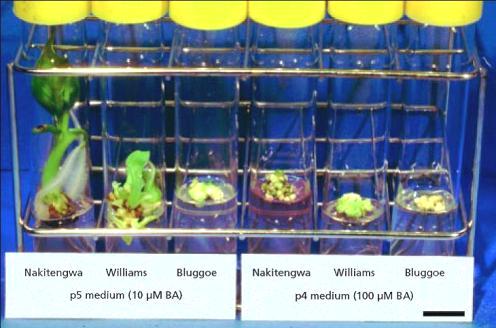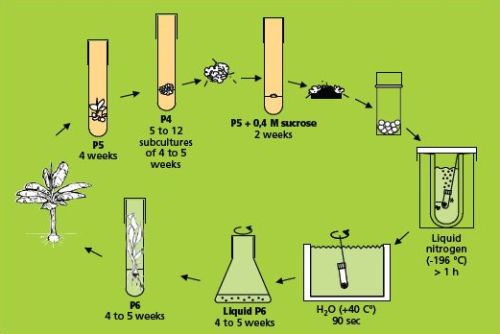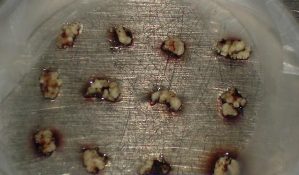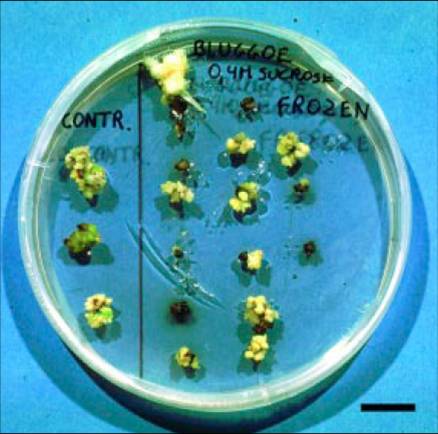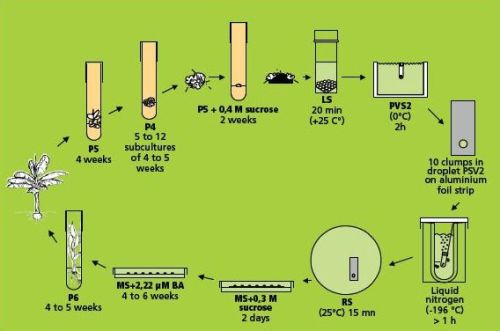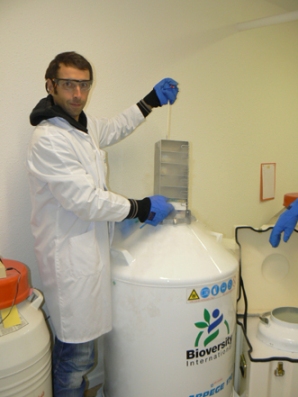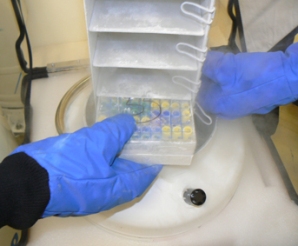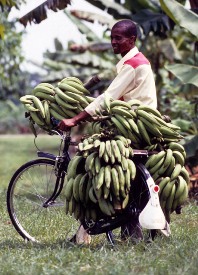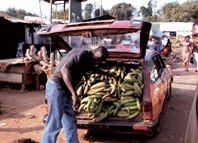CGKB News and events Banana
|
Importance and origin Banana (Musa spp.) is one of the most ancient fruit crops known and used by man. It originated in South-East Asia and was first domesticated some 7000 years ago. Today it is grown in every humid tropical and many sub-tropical regions. It is the fourth most valuable food crop after rice, wheat and maize. The fruit crop provides a staple food source for 400 million people, most important in East–Africa. About 95 million metric tons of bananas are harvested annually around the world, 30% of these being plantains. About 90% of the total production takes place on small-scale farms and it is used for home consumption or in domestic markets. The remaining 10% (dessert bananas) are mostly produced in Latin-America and Caribbean and commercialized in world trade.
Production of banana in the world
|
|
|
How is it consumed? For many people in the tropics, bananas are an essential component in their daily diet.
Bananas are essential for many people in the tropics
|
|
|
Which types exist? Bananas evolved from inter-and intraspecific hybridization between two diploid wild species of the genus Musa, sp. acuminata (AA) and sp. balbisiana (BB), the only species that set seeds. These crosses produced edible cultivars (all female sterile with various levels of male sterility) currently cultivated, with the following genomic configuration:
|
|
|
Further reading: Simmonds and Shepherd, 1955 |
Cryopreservation of banana meristem clusters (cauliflower-like structures)
.jpg) View the full publication on Cryopreservation of Musa germplasm by clicking on the icon above (1.35 MB) |
Contributors to this page: Bioversity International, Belgium (Bart Panis).
The content of this page was extracted from Panis B. 2009. Cryopreservation of Musa germplasm: 2nd edition. Technical guidelines No.9 (F. Engelmann and E. Benson, eds). Bioversity International, Montpellier, France.
A second type of regenerative meristematic tissue in banana which has been successfully cryopreserved is the highly proliferating (sometimes called cauliflower-like) meristem clusters. This tissue type was originally produced as a starting material to initiate embryogenic cell suspension cultures in bananas (Dhed’a et al. 1991, Strosse et al. 2006, Schoofs 1997).
Two cryopreservation techniques applied to highly proliferating ‘cauliflower-like’ meristem clusters are described below:
Contents: |
Preparation of plant materials
|
Meristem cultures of banana cultivars Nakitengwa (AAA highland banana), Williams (AAA group) and Bluggoe (ABB group) on (left) p5 medium (containing 10μM BA), and (right) p4 medium (containing 100μM BA)(bar = 2 cm) (photo: KULeuven/Bioversity) |
Production of ‘cauliflower-like’ meristem clusters
To produce this kind of material in all Musa accessions, meristem cultures are transferred to a medium containing a high concentration of BA (P4 medium, see Appendix 1). Every one to two months, the material is subcultured and small clumps of ‘cauliflower-like’ meristems are selected and transferred to fresh medium (Strosse et al. 2006). The high BA concentration (up to 100 μM) in the P4 medium suppresses outgrowth of meristems, thereby favouring the formation of numerous white apical domes (see photo on the right). Repeated subculturing is necessary and can take
4-12 months.
Preculture of meristem clumps
- Following the appearance of ‘cauliflower-like’ clusters, and four weeks after the last subculture, white meristematic clumps of about 4mm diameter, each containing at least four apical domes, are excised and transferred onto preculture medium (P5 + 0.4 M (= 136.8 g/L) sucrose) for four weeks. They are cultured at 25°C ± 2°C in darkness.
Discussion and perspectives
The quality of ‘cauliflower-like’ meristem clumps may be too poor for use in cryopreservation experiments (meristematic tissue versus corm tissue is too low and/or the explant shows too much blackening). This can be due to the fact that the cultivar belongs to a ‘difficult’ genomic group (for example East African highland bananas and many plantains). Previously, proliferation was only obtained by using BA at extremely high, nearly toxic, concentrations (100 μM). Prolonged culture on 100 μM BA containing media, therefore, often results in a quality decrease (loss of the typical ‘cauliflower-like’ characteristics) of the cultures. Recently, the use of alternative cytokinins like thidiazuron (TDZ) at lower concentration (1 μM) proved to increase proliferation rates (Strosse et al. 2008).
The simple freezing method (which involves sucrose preculture)
This method (Panis et al. 1996) is illustrated below.
|
The simple freezing method (figure: KULeuven/Bioversity) |
Cryopreservation
|
Precultured meristem clumps of "Musa schizocarpa"
Petri dish containing control (left) and frozen (right) meristematic clumps of the cv. Bluggoe (ABB group), eight weeks after cryopreservation (bar = 1 cm) |
- Small white meristematic clumps weighing 5-15 mg (2-3 mm diameter), containing three to six meristematic domes, are excised from the precultured clumps. Brown tissues are removed and only the healthiest parts, as indicated by a white-yellowish colour, are retained.
- The clumps are transferred to sterile cryotubes (2 ml) without any liquid solution and plunged directly into a Dewar flask containing liquid nitrogen. Each cryotube contains 7-10 clumps. At this stage, samples can be stored for the long term by transferring the cryotubes to the liquid nitrogen tank, ensuring that their transfer from one container to the other takes place rapidly (within a few seconds), thereby preventing slow lethal re-warming of samples.
Re-warming and recovery
- After storage, rapid thawing takes place by stirring the frozen cryotube in a water bath at 40°C for 90 seconds.
-
Regeneration of the frozen meristems can be carried out in two different ways:
- Meristems are transferred to 9 cm Petri dishes containing semi-solid regeneration medium (P6) and sealed with parafilm.
- Alternatively, regeneration can be executed in liquid medium. Thawed meristems are transferred to 100 ml Erlenmeyer flasks containing 30 ml of liquid regeneration medium (P6 without solidifying agent) and placed on a rotary shaker at 70 rpm.
- After one week of culture in dark conditions, Petri dishes and flasks are transferred to continuous light at 50 µE m-2 s-1. Cultures are kept at all times at 25°C ± 2°C.
- Three weeks after transferring to the regeneration medium, frozen meristem regrowth is determined under a binocular microscope. Two types of surviving tissues are distinguished, i.e. shoots and non-regenerating callus. All calluses are systematically discarded and only recovered shoots (see photo on the right) are transferred to test tubes with regeneration medium to promote further development of whole plants. As soon as rooted plants are sufficiently developed, they are planted in soil.
Discussion and perspectives
The simple freezing protocol was applied to 36 banana cultivars belonging to 8 genomic groups (Panis et al. 2002). The results were extremely genotype dependent. Best results (up to 70% regrowth) have been obtained with the ABB cultivars like Bluggoe, Cachaco and Monthan. Intermediate results (around 25% regrowth) were reached with AAA dessert and AAB bananas. AAB plantains and diploids generally respond poorly. For all cultivars under investigation belonging to these genomic groups, plants were regenerated and grown in the greenhouse. However, most of the AAA Highland bananas were not able to withstand simple freezing.
With regard to this simple freezing method, blackening, due to the oxidation of polyphenols is often observed when re-warmed meristems are placed on semi-solid medium. This can cause cytotoxic effects and may also result in the recovering clumps being surrounded by an impermeable layer, thereby preventing nutrient uptake for further outgrowth. One method to overcome this problem is to use liquid regeneration media in order to dilute the released polyphenols. This resulted in regeneration percentages that were up to 20% higher
The droplet vitrification of ‘cauliflower-like’ meristem clusters method (combining simple freezing with droplet-vitrification)
This method (Panis et al. 2000, Agrawal et al. 2004) is illustrated in the figure below. Loading, dehydration, rapid freezing, storage, re-warming and unloading are almost identical to the droplet vitrification described in the page on Cryopreservation of banana apical meristems. Therefore, only the essential (and differential) steps are indicated in detail below.
|
Droplet vitrification protocol of meristem clumps (figure: KULeuven/Bioversity) |
Loading, dehydration and rapid freezing
|
Meristem clumps in a droplet of PVS2 solution (of about 15 μl) on a strip of aluminium foil (5x20 mm) |
- The excised sucrose precultured meristem clumps are left in the loading solution (see Appendix 1) in a 20 ml plastic vessel until all of them are dissected. The exposure time thus varies between 20 min. and 3 hrs.
- After loading, the solution is replaced by ice-cooled PVS2 solution (see Appendix 1). The meristem clumps are subjected to the PVS2 solution for 2 hrs. at 0°C. Five min before the end of the treatment, about ten meristem clumps are transferred to one droplet of PVS2 solution on a strip of aluminium foil (5x20 mm) with a forceps and a 2 ml plastic Pasteur pipette (see photo).
- To keep the temperature of the strip around 0°C during the manipulations, it is placed in a plastic Petri dish placed on top of a frozen cooling element. After the PVS2 treatment, the aluminium strip is plunged into liquid nitrogen with a fine forceps. For permanent cryostorage, the frozen foil is quickly transferred to a 2 ml cryotube filled with liquid nitrogen and closed.
Storage, re-warming and unloading
- The meristem clumps are kept in liquid nitrogen for at least 20 min. For re-warming, aluminium foil strips are plunged in 10 ml unloading solution (see Appendix 1) in a small Petri dish at room temperature. After a few seconds, meristem clumps are released from the aluminium foil and kept for another 15 min in the unloading solution. As such, the toxic PVS2 solution is removed whilst re-warming and replaced by a less-toxic unloading solution.
Recovery
- Frozen meristem clumps are taken from the unloading solution and placed in 9 cm plastic Petri dishes on two sterile filter papers on top of about 25 ml semi-solid hormone-free MS medium containing 0.3 M (= 102.6 g/L) sucrose.
- After two days, the filter paper is removed and the meristem clumps are transferred to Petri dishes with MS medium supplemented with 2.22 μM BA. The first week of culture always takes place in the dark.
- After a maximum of six weeks, meristem clumps are transferred to test tubes with P6 medium for further development of whole plants (see photos below).
 |
 |
|
Regenerating shoots from one control and three frozen proliferating meristems of the cultivars ‘Kisubi’ (AB group) ‘Dominico Harton’ (AAB plantain), ‘Bluggoe’ (AAB group) and ‘Williams’ (AAA group) three months after cryopreservation (photos: KULeuven/Bioversity) |
|
Discussion and perspectives
It has been found that post re-warming regrowth percentages of sugar pregrown meristems are higher compared to those grown on normal P4 medium. Sucrose preculture seems to increase tolerance of meristems not only towards the PVS2 solution but also towards the damaging events taking place during the cooling process. When comparing the results from the droplet vitrification of ‘cauliflower-like’ meristem clusters with those obtained using the simple freezing method for the same cultivar, an increase in viability percentages for almost all cultivars is observed. The increase in post-thaw regeneration for the ABB bananas is limited. Recovery remains between 50 and 70%. For AAA dessert and AAB bananas, the increase of regeneration percentages amount to 30-50%, while for plantains 20-30% is reached. AAA Highland bananas which proved to be recalcitrant towards cryopreservation using simple freezing give 0-20% survival using the droplet vitrification method.
For most plant species, optimal dehydration of meristematic tissues with PVS2 is obtained after 10-30 min. at room temperature (Takagi 2000). Among the exceptions are shoot apices of sweet potato and pineapple which need to be treated with PVS2 for 100 min. and 7 hrs., respectively (Plessis and Steponkus 1996, Gonzalez-Arnao et al. 1998). The duration of this treatment has to be optimized case by case since enough dehydration must take place to avoid the formation of lethal ice crystals during freezing. At the same time care has to be taken to prevent the treatment with the potentially toxic solution from irreversibly damaging the tissue. In the case of sucrose precultured proliferating banana cultivars, it has been observed that optimal post re-warming regeneration percentages are generally obtained after a 2 or 2.5 hr. PVS2 treatment. Survival after 3 hrs for most cultivars is considerably lower, probably due to the toxicity of this highly concentrated solution.
References and further reading
Agrawal A, Swennen R, Panis B. 2004. A comparison of four methods for cryopreservation of meristems in banana (Musa spp.). CryoLetters 25:101-110.
Dhed’a D, Dumortier F, Panis B, Vuylsteke D, De Langhe E. 1991. Plant regeneration in cell suspension cultures of the cooking banana cv. ‘Bluggoe’ (Musa spp., ABB group). Fruits 46 (2):125-135.
Gonzalez-Arnao MT, Ravelo MM, Villavicencio CU, Montero MM, Engelmann F. 1998. Cryopreservation of pineapple (Ananas comosus) apices, CryoLetters 19: 375-382.
Panis B. 2009. Cryopreservation of Musa germplasm: 2nd edition. Technical Guidelines No. 9 (F. Engelmann and E. Benson, eds). Bioversity International, Montpellier, France. Available here.
Panis B, Schoofs H, Thinh NT, Swennen R. 2000. Cryopreservation of proliferating meristem cultures of banana. In: Engelmann F, Takagi H, editors. Cryopreservation of tropical plant germplasm. Current research progress and application. Japan International Research Center for Agricultural Sciences, Tsukuba, Japan / International Plant Genetic Resources Institute, Rome, Italy. pp. 238-243.
Panis B, Strosse H, Van den Hende S, Swennen R. 2002. Sucrose preculture to simplify cryopreservation of banana meristem cultures. CryoLetters 23:375-384.
Panis B, Totté N, Van Nimmen K, Withers LA, Swennen R. 1996. Cryopreservation of banana (Musa spp.) meristem cultures after preculture on sucrose. Plant Science 121:95-106.
Plessis P, Steponkus PL. 1996. Effect of preculture in a sucrose-containing medium on the sugar content of potato shoot-tips, Cryobiology 33: 654-655.
Schoofs H. 1997. The origin of embryogenic cells in Musa. Dissertationes de Agricultura 330. Katholieke Universiteit Leuven, Belgium. 257 pp.
Strosse H, Schoofs H, Panis B, André E, Reyniers K, Swennen R. 2006. Development of embryogenic cell suspensions from shoot meristematic tissue in bananas and plantains (Musa spp.). Plant Science 170:104-112.
Strosse H, André E, Sági L, Swennen R, Panis B. 2008. Adventitious shoot formation is not inherent to micropropagation of banana as it is in maize. Plant Cell Tissue and Organ Culture 95:321-332.
Takagi H. 2000, Recent developments in cryopreservation of shoot apices of tropical species. In: Engelmann F, Takagi H, editors. Cryopreservation of tropical plant germplasm. Current research progress and application. IPGRI, Rome, Italy. pp. 178-193.
Cryo storage for banana genetic resources
.jpg)
View the full publication on Cryopreservation of Musa germplasm by clicking on the icon above |
Contributors to this page: Bioversity International, Belgium (Bart Panis).
The contents of these Cryo pages were extracted from Panis B. 2009. Cryopreservation of Musa germplasm: 2nd edition. Technical guidelines No.9 (F. Engelmann and E. Benson, eds). Bioversity International, Montpellier, France.
Introduction
In the last 20 years, several new cryopreservation procedures like vitrification, encapsulation-dehydration, preculture-dehydration, and encapsulation vitrification have been established, which are all based on vitrification. Vitrification can be defined as the transition of water directly from the liquid phase into an amorphous phase or glass, whilst avoiding the formation of crystalline ice. Cryopreservation protocols based on vitrification techniques have been developed for different vegetatively propagated crops, including banana (Sakai and Engelmann 2007).
When cryo banks are used
|
‘Cryopreserving’ samples or placing samples into a state of suspended animation in liquid nitrogen (photo: Bioversity) |
|
|
A box containing cryotubes (photo: Bioversity) |
Research on cryopreservation of Musa was initiated in the 1990ties at Bioversity International Transit Center (ITC, previously INIBAP). The main objective was to:
- Overcome some of the limitations of in vitro maintenance (labour-intensive subculturing, potential for fungal and bacterial contaminants, as well as the risk for somaclonal variation).
- To ensure the safe long-term conservation of Musa genetic resources.
Current situation
Bioversity-supported research at KULeuven has resulted in the development of three cryopreservation protocols suitable for the long-term storage of meristem cultures of banana.
- The first method relies on rapid freezing of highly proliferating meristem cultures, precultured for two weeks on medium with 0.4 M (136.8 g/L) sucrose.
- The second method also uses highly proliferating meristem cultures that are precultured on sucrose but they receive an additional vitrification treatment.
- The third and most generally applicable protocol is the vitrification of apical meristems excised from rooted in vitro plants.
The labour requirement to cryopreserve accessions, as well as the post-re-warming regeneration percentages, depends on the cultivar and the method used (Panis et al. 2007).
The application of the aforementioned protocols has resulted thus far in the safe storage in liquid nitrogen of 882 accessions (situation September 2013) belonging to the different genome groups within the genus Musa.
Detection of endophytic bacteria
During normal meristem culture and storage under limited growth conditions, the presence of endogenous bacteria is rarely observed. If present, often such bacteria do not interfere with the growth of meristem cultures. However, as soon as meristems are subjected to cryopreservation, growth of endogenous bacteria becomes a problem. As the meristems begin to regrow following cryopreservation, endogenous bacteria present can develop into yellow or white colonies, which overgrow the recovering meristem.
- Prior to cryopreservation, cultures should always be screened for the presence of endophytic bacteria on a bacterial growth medium (BACT medium) containing 23 g/L Difco® Bacto nutrient broth, 10 g/L glucose and 5 g/L yeast extract (van den Houwe and Swennen 2000).
- The plates should be incubated for three weeks in the light at 28°C.
- Accessions with a positive response to bacterial screening should be discarded (Hamill et al. 2005, Thomas et al. 2008, Van den Houwe and Swennen 2000).
Method of cryopreservation at the ITC
- Currently, the droplet-vitrification of apical meristems, as well as the droplet-vitrification of ‘cauliflower-like’ meristem clusters, are both applied to the Musa collection.
- The simple freezing method is no longer applied for these purposes in view of the relatively low post-thaw regeneration percentages obtained for most genomic groups.
The table below compares the labour requirement for the two methods that are now applied.
Table: Comparison of labour requirement for two cryopreservation protocols.
|
Freezing method |
Labour time |
cvs/person |
Time needed |
Cultivars |
|
Vitrification of proliferating clumps |
30 to 40 |
59 to 44 |
12 to 13 |
ABB |
|
Vitrification of individual meristems |
60 to 70 |
29 to 25 |
8 to 9 |
AAAh bananas |
|
1: Calculated time needed to prepare the culture media and meristem cultures followed by cryopreservation. |
||||
- The most labour intensive method (vitrification of apical meristems excised from rooted in vitro plants) should only be applied to the cultivars which are difficult to cryopreserve with the other method (for example AAA highland bananas).
- For banana accessions belonging to the ABB group and AAB (non-plantain) bananas, the droplet-vitrification of proliferating clumps is always applied.
- The preferred method for Musa acuminata and the East African highland bananas is the droplet-vitrification of apical meristems.
- For all other accessions, the method of choice is based on (i) the proliferation degree of the meristem clumps that are obtained after three subculture cycles on a medium containing high cytokinin concentrations and (ii) survival of the proliferating meristem clumps after a preliminary cryopreservation trial.
To decide whether a cryopreservation experiment is successful or not, the mode of calculation developed by Dussert and coworkers (2003) should be used. These calculations have been applied to all ITC data.
An experiment is considered successful provided that the chance to regenerate at least one shoot from the stored material is more than 95%. This probability depends on:
(i) the number of explants stored in liquid nitrogen (in the long-term ranging between 30 and 50);
(ii) the number of explants re-warmed (ranging between 16 and 50); and
(iii) the post re-warming regeneration percentage (%).
An experiment leading to a lower probability level will not be considered successful, irrespective of its regeneration percentage. In such cases, the repetition is discarded and a new repetition will be executed.
A banana accession is considered “safely” preserved if three independent (and successful) experiments are completed. According to these requirements, ITC is currently storing 882 accessions belonging to 30 different genomic banana groups in liquid nitrogen (situation September 2013).
References and further reading
Agrawal A, Swennen R, Panis B. 2004. A comparison of four methods for cryopreservation of meristems in banana (Musa spp.). CryoLetters 25:101-110.
Hamill S, Wasmund K, Smith M, Eccleston K, McKay D. 2005. Endogenous bacterial isolated from banana meristems during tissue culture initiation: problems and potential. In: Benett IJ, Bunn E, Clarke H, McComb JA. editors. Contributing to a Sustainable Future. Proc. Australian Branch IAPTC & B. Perth, Western Australia, AU. pp.101-111.
Panis B. 2009. Cryopreservation of Musa germplasm: 2nd edition. Technical Guidelines No. 9 (F. Engelmann and E. Benson, eds). Bioversity International, Montpellier, France. Available here.
Panis B. 2008. Cryopreservation of Monocots. Chapter 11. In: Reed BM, editor. Plant Cryopreservation: A Practical Guide. Springer Science+Business Media, LLC. pp. 241-280.
Panis B, Helliot B, Strosse H, Remy S, Lepoivre P, Swennen R. 2005. Germplasm conservation, virus eradication and safe storage of transformation competent cultures. In: Chang WC, Drew R, editors. Banana: The importance of cryopreservation. Proceedings IInd IS on Biotech. of Trop. & Subtrop. Species. Acta Horticulturae 692. ISHS. pp. 51-59.
Panis B, Lambardi M. 2006. Status of cryopreservation technologies in plants (crops and forest trees). Chapter 6. In: Ruane J, Sonnino A, editors. The role of biotechnology in exploring and protecting agricultural genetic resources. Food and Agriculture Organization of the United Nations, Rome, Italy. pp. 61-78.
Panis B, Piette B, André E, Van den houwe I, Swennen R. 2011. Droplet vitrification: the first generic cryopreservation protocol for organized plant tissues? Acta Horticulturae 908:157-164
Panis B, Piette B, Swennen R. 2005. Droplet vitrification of apical meristems: a cryopreservation protocol applicable to all Musaceae. Plant Science 168:45-55.
Panis B, Strosse H, Helliot B, Lepoivre P, Remy S, Elsen A, De Waele D, Swennen R. 2002. Cryopreservation as a tool to store banana meristems and embryogenic cells, its nematodes and for virus eradication. 3rd International Symposium on Molecular and Cellular Biology of Bananas. Leuven, Belgium, 9-11 September 2002. 48 pp.
Panis B, Strosse H, Remy S, Sági L, Swennen R. 2004. Cryopreservation of banana tissues: support for germplasm conservation and banana improvement. In: Mohan Jain S, Swennen R, editors. Banana Improvement: Cellular, Molecular Biology, and Induced Mutations. Science Publishers Inc., Enfield, NH, USA:13-21. Available from: www.fao.org/docrep/007/ae216e/ae216e04.htm#bm04 Date accessed: 23 March 2010.
Panis B, Strosse H, Van den Hende S, Swennen R. 2002. Sucrose preculture to simplify cryopreservation of banana meristem cultures. CryoLetters 23:375-384.
Panis B, Thinh NT. 2001. Cryopreservation of Musa germplasm. INIBAP Technical Guidelines 5 (Escalant JV, Sharrock S, editors). International Network for the Improvement of Banana and Plantain, Montpellier, France. Available here.
Panis B, Totté N, Van Nimmen K, Withers LA, Swennen R. 1996. Cryopreservation of banana (Musa spp.) meristem cultures after preculture on sucrose. Plant Science 121:95-106.
Panis B, Van den Houwe I, Piette B, Swennen R. 2007. Cryopreservation of the banana germplasm collection at the International Transit Centre - Bioversity International. Advances in Horticultural Science 21 (4):235-238.
Sakai A, Engelmann F. 2007. Vitrification, encapsulation-vitrification and droplet-vitrification. CryoLetters 28:151-172.
Sakai A, Kobayashi S, Oiyama I. 1990. Cryopreservation of nucellar cells of navel orange (Citrus sinensis Osb. var. brasiliensis Tanaka) by vitrification. Plant Cell Reports 9:30-33.
Strosse H, Schoofs H, Panis B, André E, Reyniers K, Swennen R. 2006. Development of embryogenic cell suspensions from shoot meristematic tissue in bananas and plantains (Musa spp.). Plant Science 170:104-112.
Swennen R, Markham R, Frison E. 2004. Applying biotechnology in banana and plantain: implications for developing countries. PBI Bulletin. Issue 2. Biotechnology and developing countries. The potential and the challenge. NRC-CNRC Plant Biotechnology Institute, Canada. pp. 22-27.
Thinh NT, Takagi H, Yashima S. 1999. Cryopreservation of in vitro-grown shoot tips of banana (Musa spp.) by vitrification method. CryoLetters 20 (3):163-174.
Thomas P, Swarna GK, Roy PK, Patil P. 2008. Identification of culturable and originally non-culturable endophytic bacteria isolated from shoot tip cultures of banana cv Grand Naine. Plant Cell Tissue and Organ Culture 93:55-63.
Van den Houwe I, Swennen R. 2000. Characterization and control of bacterial contaminants in in vitro cultures of banana (Musa spp.). Meeting: International Symposium on Methods and Markers for Quality Assurance in Micropropagation. Acta Horticulturae 530:69-79. An abstract and purchase of the publication is available from: www.actahort.org/books/530/530_6.htm. Date accessed: 23 March 2010.
Van den Houwe I, Panis B, Arnaud E, Markham R, Swennen R. 2006. The management of banana (Musa spp.) genetic resources at the IPGRI/INIBAP gene bank: the conservation and documentation status. In: Segers H, Desmet P, Baus E editors. Tropical biodiversity: science, data, conservation. Meeting: 3rd GBIF Science Symposium, Brussels, 18-19 April 2005. pp. 141-150. Available here. (8MB)
Wang QC, Panis B, Engelmann F, Lambardi M, Valkonen J. 2009. Cryotherapy of shoot tips: a technique for pathogen eradication to produce healthy planting materials and prepare healthy plant genetic resources for cryopreservation. Annals of Applied Biology 154:351-363.
Viability and monitoring for banana (field)
Viability and monitoring for musa (field)
Distribution of banana genetic resources
Contributors to this page: Bioversity International, Belgium (Ines Van den Houwe); Bioversity International, France (Nicolas Roux); IIITA, Nigeria (Dominique Dumet, Badara Gueye); CIRAD, France (Jean-Pierre Horry).
|
|
Banana users (Photo: IITA) |
|
|
Banana users (Photo: IITA) |
An important role of in vitro genebanks is the distribution of germplasm to different users.
Click here to open a PDF document that shows how to disseminate general germplasm in detailed steps.
|
Contents: |
Common policies on distribution and access to plant material
- Follow the International Treaty on Plant Genetic Resources for Food and Agriculture (ITPGRFA) for in-trust germplasm using the Standard Material Transfer Agreement (SMTA).
For germplasm of crops listed in Annex 1 (click here for details), including cultivated Musa that will be used for breeding, research and training for agriculture, the Standard Material Transfer Agreement (SMTA) should be used for all distribution, both from CGIAR genebanks and from Contracting Parties.
1) If the material meets the health status requirements for distribution (i.e. it is virus indexed negative for all viruses). If an accession is not available for distribution because of its health status, the requester will be informed and a suitable alternative accession should be proposed, if available.
2) The removal of samples for distribution should not reduce the stocks to below the accepted level for conservation. If only a limited number of replicates of the accessions is present in storage, the accession should be immediately reproduced and the requester will be informed that the request cannot be immediately or fully met.
An order form should be sent to the requester with the agreed list of accessions and the relevant Material Transfer Agreements (MTAs) should be attached to it. The applicant should be asked to complete the order form and to acknowledge acceptance (signature/shrink-wrap mode) of the terms and conditions of the applicable MTAs. The requester should be asked to indicate the type of plant material and number of samples (if not standard) he/she wishes to receive.
Policy exceptions
- None.
National laws and regulations
It is essential to follow the terms and conditions in the host country agreements:
- Export permits.
- Phytosanitary certificate.
- Certificate of origin.
International laws and regulations
The shipment of plant material should be sent with the Standard Material Transfer Agreement under the International Treaty for Plant Genetic Resources for Food and Agriculture.
Phytosanitary regulations
See the Safe Transfer of Germplasm (STOG) section in this website for seed health movement (this is essential to avoid spread of pests and diseases).
- Phytosanitary certificates are needed for most countries.
- It is the responsibility of the requester to supply the genebank with all plant quarantine documents (plant importation permit/import permit labels) from the importing country required to enable the introduction of the requested germplasm into the importing country.
- For germplasm requests outside the EU (in the case of ITC), shipments of germplasm always need to be accompanied by a phytosanitary certificate (PC).
- Upon receipt of the completed order from, acceptance of the MTAs and (copy of) the necessary import documents, the genebank normally applies to its own country laws for a phytosanitary certificate, including the additional declarations exactly as required by the importing country. Only if the conditions of the phytosanitary certificate are in compliance with the conditions of the plant importation permit of the importing country, the introduction of the material into the importing country will be successful.
- For requests of banana germplasm within the EU (in the case of ITC), a plant passport (PP) delivered by the Agency, is required. In some cases the importing country also requires a certificate of origin (CO), stating the exact (oldest traceable) origin of the germplasm. This document should be generally issued by the genebank hosted country.
- When the plant material is ready for shipping, an inspection of the material to be exported should be arranged with the Agency, in order to ensure that additional requirements of the importing country are fulfilled.
User related issues for distribution
Feedback to users
Factors that can influence the delivery of plant materials:
- Respond to requests with lists of material, forms and conditions of access, SMTA as soon as possible after receipt of request (users may not know about the conditions so it is better to inform them before proceeding with the request).
- Provide passport and germination data with requests.
Recommended procedures that ensure the material distributed matches the client request:
- On specific requests, match accession numbers with specified request.
-
If accession numbers are not specified, match accessions to users' needs. These could include:
- Species.
- Plant habit to fit the crop system.
- Environment.
- Use.
Feedback from users
The most relevant information required to be received from the users is as follows:
- Information on characterization and evaluation/use (information on performance in one area allows better selection of germplasm for similar areas).
Quantity of material recommended to be distributed
It must be sufficient to cover the diversity in the accession and produce material for future use (users should have access to the full diversity within the accession and sufficient plant material to multiply in order to obtain a genetically similar sample for future use. The provision of small quantities maintains the stocks and reduces the multiplication frequency.
In order to meet users requirements, three types of material can be made available:
- Proliferating shoot tip cultures. Usually proliferating tissue cultures are supplied for further propagation or studies in vitro.
- Individual rooted plantlets are supplied if the requester is not able to handle clusters of multiple shoot or bud cultures and they are suitable for immediate soil planting under controlled conditions (nursery).
- Freeze dried leaf tissue suitable for molecular studies (DNA, RNA and protein research).
As a standard, five samples of living tissues (shoot tip cultures or rooted plants) should be provided per accession. For leaf tissue samples usually one packet containing 0.5 g tissue (fresh weight) should be supplied.
The applicant should be requested to give a short description of the intended research use of the requested material.
Availability check
Availability of stock
- Check availability of vegetative material in the field or laboratory.
- Distribution of the requested material should not cause (i) the accession to fall below the minimum stock level or (ii) distribution of vegetative cuttings should not cause plant death.
- Unhealthy accessions or those with little vegetative material should not be distributed.
Checking passport data
- Passport data can be checked to ensure that the species is adapted to the requester’s needs (this avoids waste of germplasm by sending material that the requester does not need or want).
|
Proliferation tissue for shipping |
Preparing vegetative materials for distribution
Proliferating shoot tip cultures
- Propagules of the requested accession should be taken from the stock in MTS and re-propagated in 50 ml plastic culture vessels containing 10 ml proliferation medium and closed with a screw cap.
- The culture vessels should be incubated under normal growth conditions (incubated at 28oC for 14 days at light intensity) for three weeks, before shipping.
Before propagules are transferred to the transport vessels, they should be indexed for bacterial contamination.
- If the importing country requires that the material is free of specific bacterial diseases, the propagules should be tested on a selective medium for the pathogens concerned.
In vitro rooted plantlets
- A few tissue culture samples of the requested accession should be retrieved from MTS and regenerated into unrooted shoots, planted on a regeneration medium with less cytokinins.
- These should be aseptically transferred to Cultu saks®, gas-permeable plastic tissue culture bags which can be heat sealed watertight but allow gas exchange.
- Cultu saks® are easy, economical, light and unbreakable and thus very suitable for transportation of plant tissue.
- The bags must contain a semisolid root-inducing culture medium, containing half strength macronutrients of MS salts, MS vitamins, enriched with 15 gl-1 sucrose and 1 µM of the auxin IBA (indolebutyric acid) to promote root formation.
- The roots usually appear within ten days.
- Plants can be kept viable for several months in these cultu saks awaiting a convenient moment for planting at the recipients facilities.
Lyophilized leaf tissue
The required number of samples of each requested accession should be removed from the lyophilized leaf bank.
- A standard of one sample bag per accession should be provided.
Dispatching of plant material
The plant material should be labelled with the accession ID and name. It should be packed in a cardboard box coated with shock absorbent plastic to avoid damage to the culture containers during transit. Inside the parcel the following documents should be enclosed:
- A shipment notice or cover letter with a copy of the relevant MTAs, signed and dated by the Provider and User.
- A packing list with the details of the parcel’s content (the Provider and name of the accession enclosed, the type of cultures and the number of replicates).
- A health statement with the results of the virus indexing tests undertaken on the shipped accession.
- The accession passport data.
- A receiving report: the recipient is requested to fill out and return a fax report sheet to acknowledge receipt and to inform the provider on the status of the plant material upon arrival.
- An information sheet regarding the handling of in vitro propagules accompanies the shipped germplasm. For proliferating tissue cultures this includes the composition of the culture media to be used for the further propagation of the plants. Where in vitro rooted plants are shipped, post-flask handling instructions for the tissue culture plants are provided.
The consignment should be shipped by Express Mail in order to keep the journey as short as possible and minimize the risk of deterioration of the plant material.
Recording information during distribution
System for tracking material/inventory system for distribution
- Update related data tables in database management system (a database system allows easy and fast access to data and allows macros to be written for routine operations).
- Use labels with good adhesive and clear printing (this avoids errors and mixing of material during shipping).
References and further reading
Tenkouano A, Swennen R. 2004. Progress in breeding and delivering improved plantain and banana to African farmers. Chronica Horticulturae 44(1):9-15.
Van den Houwe I, Jones DR. 1994. Musa germplasm distribution from the INIBAP Transit Center. Meeting: First Global Conference of the International Musa Testing Program, La Lima (HND), 27-30 April 1994. Publisher: INIBAP, Montpellier (France). Available here.
Van den Houwe I, Panis B. 2000. In vitro conservation of banana: medium term storage and prospects for cryopreservation. In: Razdan MK, Cocking E, editors. Conservation of Plant Genetic Resources in vitro. Vol. 2. M/S Science Publishers, USA. pp. 225-257.
More Articles...
Subcategories
-
main
- Article Count:
- 2
-
Registration of Musa
Registration and information systems - Importance and uses
Registration is the first step after acquisition of a sample in any genebank. Collections in genebanks are the genetic base for current and future breeding programs and a source of safety material for distribution to researchers and other users. It is essential that samples are all properly documented from the moment they enter a genebank as well as through all subsequent genebank operations.
A step by step guideline can be seen by clicking here.How should it be done?
Information systems
An information management system must be created in each genebank. This database must be searchable by the genebank curators and staff for specific information through a range of queries.
Numbering and labelling systems
Consecutive alpha numeric or numeric codes must be used for each new accession acquired. This code must be linked to all subsequent information about this sample: passport data, designation status and taxonomic information. The information system must keep a record of genebank operation data, including storage location, stocks, monitoring, health tests and the distribution status. The same system must also manage germplasm orders, shipment related information and files genebanks ‘contacts’ information.
Bar-coding is a useful tool that can compliment a genebank information system.
Extra samples
A separate subset of materials should be kept after registration to be regenerated under greenhouse conditions for harvesting leaf samples that can be processed for DNA/lyophilized leaf bank. These banked leaf materials can serve as a voucher for the germplasm stored in the active and base collections and samples can be made available to users for research in gene discovery and function, marker development and detailed genotypic characterisation. Method to be detailed by INIBAP
Musa Germplasm Information Systems (MGIS)
In 1997, INIBAP laid the basis for a global information system for Musa through the release of MGIS. The aim of the system was to enhance knowledge on Musa diversity, to help rationalizing conservation and to improve the use of banana genetic resources though a facilitated access to comprehensive information.
In 2005, the MGIS database contained key information, including passport data, botanical classification, morpho-taxonomic descriptors and characteristics such as agronomic traits, disease resistance, stress tolerance, biochemical or molecular genetic markers, and plant photographs as well as GIS information on 5188 accessions managed in 18 banana collections (link to the list of collections) around the world making it the most extensive source of information on banana genetic resources.
The database is publicly accessible through the internet at MGIS homepage.htm or at www.mgis.grinfo.net. This global database can be queried on the identity, origin, characteristics and distribution of the individual accessions in the collections. This allows curators of the participant institutions worldwide to share and compare their data. The database is also particularly helpful for various germplasm users namely breeders, researchers and farmer communities, in locating alternative sources of banana germplasm and identifying the most appropriate accessions with particular traits of interest.Homepage of the MGIS website (click on the picture if you wish to go there now)
Further reading:
Van den houwe et al., 2005 (The management of banana (Musa spp.) genetic resources at the IPGRI/INIBAP gene bank: the conservation and documentation status
Calles et al., 2003 (Best Practices for Genebank Management)- Article Count:
- 1
-
Conservation of musa
- Article Count:
- 4
-
In vitro bank for banana
- Article Count:
- 4
-
Cryopreservation for musa
- Article Count:
- 3
-
In the field for musa
- Article Count:
- 3
-
Safety duplication of musa
No. of samples (tubes) per line or cultivar
Size of container
Kind of medium
Amount of medium
Labeling
Placement of label
Bioversity - written directly on cryotubes using pencil
IITA - higher halfLabeling material
Bioversity - not applicable
IITA - marker on parafilm for tubes, tape on polyethylene bagsLabel information
Bioversity - accession ID, freezing date, experiment number
IITA - accession number, line number and date of last introduction
Viability testing
Conditions or timing when the test is conducted
After being one hour in liquid nitrogenNo. of samples for testing
Bioversity - 3 cryotubes per accession (experiment)
IITA – 1-5 seedlingsCriterion for long-term storage
At least 95% certainty that a minimum of 1 plant can be regenerated per experimentTransport
Type of container
Bioversity - dry shipper
IITA – plastic boxesMethod and duration
Bioversity - Air courier or hand carried
IITA - car (4x4) 5 to 6 hours driveConditions
Bioversity - Frozen in liquid nitrogen
IITA - ambientFrequency of shipment
Bioversity - Initially 3 to 4 x a year; once a year thereafter
IITA – 3 to 4 months
Genebank for safety storage
Bioversity - IRD, France & KULeuven, Belgium
IITA - IITA Cotonou, Benin
Storage
Type of storage
Bioversity – Cryopreservation in liquid nitrogen tank
IITA – Tissue culture slow growthType of container
Bioversity - 2mL cryotubes
IITA - Polyethylene bags (13 x 1.3 cm)Temperature (in degrees Celcius)
Bioversity – (-196 oC)
IITA – 18oCLife expectancy of clones
Bioversity - Indefinite
IITA – 4-6 monthsBack-up generator
Bioversity - none
IITA - noneOther features
Availability of liquid nitrogen alarm systemData arrangements
Bioversity - Germplasm ID, inventory of box content sent with samples
IITA - mport permit stating list of accession transferred, endorsed by PQS prior to departure Report at boarder PQS office
Provision for replacement of germplasm
Bioversity - If less than 95% certainty that one minimum plant can be regenerated per experimentProvision for return of germplasm
Bioversity - Loss of samples from LTS at Bioversity ITC; sample provided by the duplication site on Bioversity's requests on a 6 month written notice
IITA - Repatriation permit to ask when needed- Article Count:
- 1







